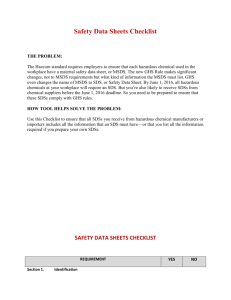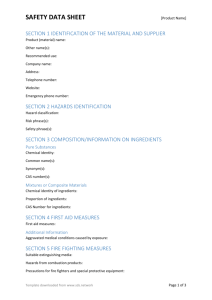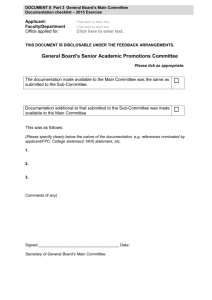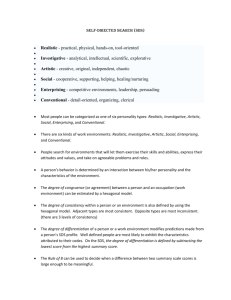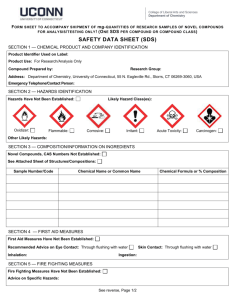Regulatory information
advertisement
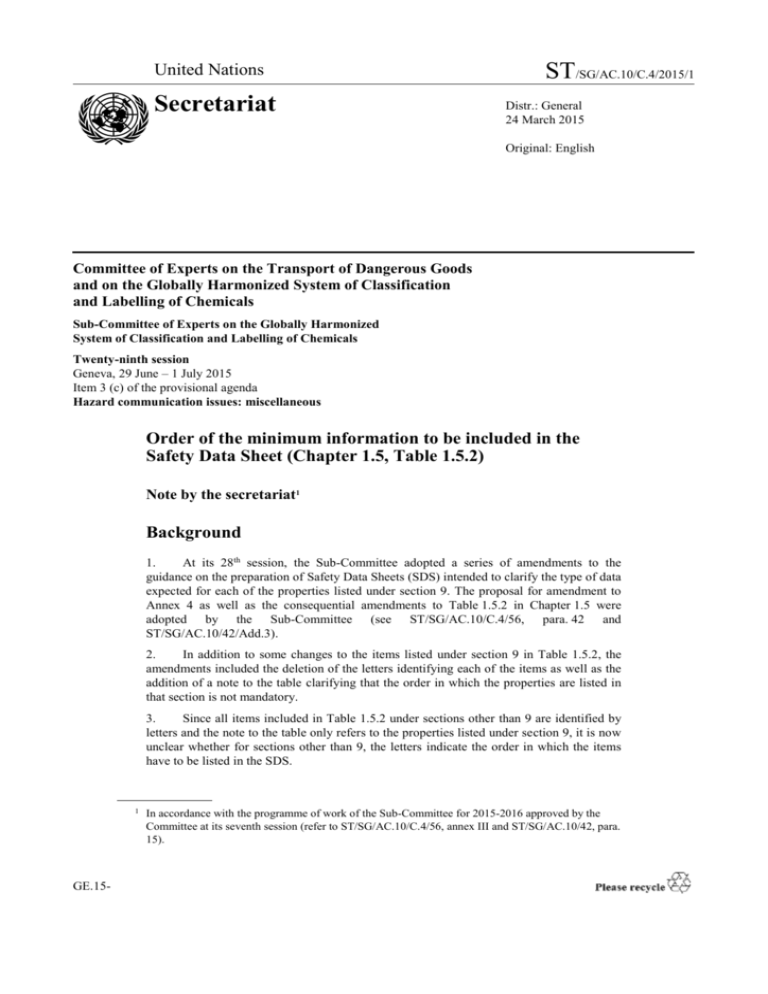
United Nations Secretariat ST/SG/AC.10/C.4/2015/1 Distr.: General 24 March 2015 Original: English Committee of Experts on the Transport of Dangerous Goods and on the Globally Harmonized System of Classification and Labelling of Chemicals Sub-Committee of Experts on the Globally Harmonized System of Classification and Labelling of Chemicals Twenty-ninth session Geneva, 29 June – 1 July 2015 Item 3 (c) of the provisional agenda Hazard communication issues: miscellaneous Order of the minimum information to be included in the Safety Data Sheet (Chapter 1.5, Table 1.5.2) Note by the secretariat1 Background 1. At its 28th session, the Sub-Committee adopted a series of amendments to the guidance on the preparation of Safety Data Sheets (SDS) intended to clarify the type of data expected for each of the properties listed under section 9. The proposal for amendment to Annex 4 as well as the consequential amendments to Table 1.5.2 in Chapter 1.5 were adopted by the Sub-Committee (see ST/SG/AC.10/C.4/56, para. 42 and ST/SG/AC.10/42/Add.3). 2. In addition to some changes to the items listed under section 9 in Table 1.5.2, the amendments included the deletion of the letters identifying each of the items as well as the addition of a note to the table clarifying that the order in which the properties are listed in that section is not mandatory. 3. Since all items included in Table 1.5.2 under sections other than 9 are identified by letters and the note to the table only refers to the properties listed under section 9, it is now unclear whether for sections other than 9, the letters indicate the order in which the items have to be listed in the SDS. 1 GE.15- In accordance with the programme of work of the Sub-Committee for 2015-2016 approved by the Committee at its seventh session (refer to ST/SG/AC.10/C.4/56, annex III and ST/SG/AC.10/42, para. 15). ST/SG/AC.10/C.4/2015/1 4. The informal working group on the revision of section 9 raised this issue in paragraph 20 of document ST/SG/AC.10/C.4/2014/21, which contained the proposals finally adopted by the Sub-Committee, as follows: “20. In addition, the Sub-Committee is invited to consider whether the numbering with letters as contained in every section of Table 1.5.2 is really necessary and appropriate. For Section 9 in Table 1.5.2 it is proposed to include the list of properties without any numbering, which is in line with the proposed footnote explaining that the order of properties within a section is not mandatory (see Annex 2 to this document). This approach might be used in the other sections in Table 1.5.2 as well by deleting all letters preceding the properties.” 5. The secretariat believes that the letters identifying each of the items in table 1.5.2 do not to indicate any specific order to be followed. This is in line with the statement made by the informal group on the revision of section 9 in paragraph 20 above (“the order of properties within a section is not mandatory”) and with the interpretation in paragraph 43 of the report of the Sub-Committee on its 28th session (see ST/SG/AC.10/C.4/56). 6. In order to avoid any misunderstanding regarding the order of the information listed in Table 1.5.2, the Sub-Committee is invited to consider the proposals below. 7. Table 1.5.2 as included in the sixth revised edition of the GHS is reproduced in the annex to this document for ease of reference. Proposal Option 1 8. Should the Sub-Committee confirm that the order in which the properties are listed under each section of table 1.5.2 is not mandatory, it is proposed to amend the note under the table as follows (inserted text is shown in bold, underlined; deleted text is shown strikethrough): “NOTE: The order of the physical and chemical properties presented in Section 9 items listed under each section may be followed on the SDS as shown in this table, but is not mandatory. The competent authority may decide to prescribe an a specific order for Section 9 of the SDS, or they may leave it to the preparer of the SDS, to re-order, the properties, if deemed appropriate.”. 9. In addition, since the note will make it clear that the order of items under each section in table 1.5.2 is not mandatory, the Sub-Committee is invited to consider harmonizing the way in which the items are listed by: (a) inserting letters (a) to (r) in section 9; or (b) keeping section 9 as it is and deleting the letters in all other sections. Option 2 10. If the Sub-Committee considers that the order of items listed in sections other than 9 is to be considered mandatory as shown in table 1.5.2, it is proposed to amend note 1 as follows (inserted text is shown in bold, underlined; deleted text is shown strikethrough): 2 ST/SG/AC.10/C.4/2015/1 “NOTE : The order of the physical and chemical properties presented in Section 9 may be followed on the SDS as shown in this table, but is not mandatory. The competent authority may decide to prescribe an order for Section 9 of the SDS, or they may leave it to the preparer of the SDS to re-order the properties, if deemed appropriate. Items under sections other than 9 should be listed in the order indicated in table 1.5.2.”. 3 ST/SG/AC.10/C.4/2015/1 Annex Table 1.5.2 Minimum information for an SDS (GHS Rev.6) Table 1.5.2 Minimum information for an SDS 4 1. Identification of the substance or mixture and of the supplier 2. Hazards identification 3. Composition/ information on ingredients 4. First-aid measures 5. Fire-fighting measures 6. Accidental release measures 7. Handling and storage 8. Exposure controls/personal protection (a) (b) (c) (d) (e) (a) GHS product identifier; Other means of identification; Recommended use of the chemical and restrictions on use; Supplier’s details (including name, address, phone number etc.); Emergency phone number. GHS classification of the substance/mixture and any national or regional information; (b) GHS label elements, including precautionary statements. (Hazard symbols may be provided as a graphical reproduction of the symbols in black and white or the name of the symbol e.g. “flame”, “skull and crossbones”); (c) Other hazards which do not result in classification (e.g. “dust explosion hazard”) or are not covered by the GHS. Substance (a) Chemical identity; (b) Common name, synonyms, etc.; (c) CAS number and other unique identifiers; (d) Impurities and stabilizing additives which are themselves classified and which contribute to the classification of the substance. Mixture The chemical identity and concentration or concentration ranges of all ingredients which are hazardous within the meaning of the GHS and are present above their cut-off levels. NOTE: For information on ingredients, the competent authority rules for CBI take priority over the rules for product identification. (a) Description of necessary measures, subdivided according to the different routes of exposure, i.e. inhalation, skin and eye contact and ingestion; (b) Most important symptoms/effects, acute and delayed. (c) Indication of immediate medical attention and special treatment needed, if necessary. (a) Suitable (and unsuitable) extinguishing media. (b) Specific hazards arising from the chemical (e.g. nature of any hazardous combustion products). (c) Special protective equipment and precautions for fire-fighters. (a) Personal precautions, protective equipment and emergency procedures. (b) Environmental precautions. (c) Methods and materials for containment and cleaning up. (a) Precautions for safe handling. (b) Conditions for safe storage, including any incompatibilities. (a) Control parameters e.g. occupational exposure limit values or biological limit values. (b) Appropriate engineering controls. (c) Individual protection measures, such as personal protective equipment. ST/SG/AC.10/C.4/2015/1 Table 1.5.2 Minimum information for an SDS 9. Physical and chemical properties 10. Stability and reactivity 11. Toxicological information 12. Ecological information 13. Disposal considerations 14. Transport information Physical state; Colour; Odour; Melting point/freezing point; Boiling point or initial boiling point and boiling range; Flammability; Lower and upper explosion limit/flammability limit; Flash point; Auto-ignition temperature; Decomposition temperature; pH; Kinematic viscosity; Solubility; Partition coefficient: n-octanol/water (log value); Vapour pressure; Density and/or relative density; Relative vapour density; Particle characteristics. (a) Reactivity (b) Chemical stability; (c) Possibility of hazardous reactions; (d) Conditions to avoid (e.g. static discharge, shock or vibration); (e) Incompatible materials; (f) Hazardous decomposition products. Concise but complete and comprehensible description of the various toxicological (health) effects and the available data used to identify those effects, including: (a) information on the likely routes of exposure (inhalation, ingestion, skin and eye contact); (b) Symptoms related to the physical, chemical and toxicological characteristics; (c) Delayed and immediate effects and also chronic effects from short and long term exposure; (d) Numerical measures of toxicity (such as acute toxicity estimates). (a) Ecotoxicity (aquatic and terrestrial, where available); (b) Persistence and degradability; (c) Bioaccumulative potential; (d) Mobility in soil; (e) Other adverse effects. Description of waste residues and information on their safe handling and methods of disposal, including the disposal of any contaminated packaging. (a) UN number; (b) UN proper shipping name; (c) Transport hazard class(es); (d) Packing group, if applicable; (e) Environmental hazards (e.g.: Marine pollutant (Yes/No)); (f) Transport in bulk (according to Annex II of MARPOL 73/78 and the IBC Code); (g) Special precautions which a user needs to be aware of, or needs to comply with, in connection with transport or conveyance either within or outside their premises. 5 ST/SG/AC.10/C.4/2015/1 Table 1.5.2 Minimum information for an SDS 15. Regulatory information 16. Other information including information on preparation and revision of the SDS Safety, health and environmental regulations specific for the product in question. NOTE: The order of the physical and chemical properties presented in Section 9 may be followed on the SDS as shown in this table, but is not mandatory. The competent authority may decide to prescribe an order for Section 9 of the SDS, or they may leave it to the preparer of the SDS to re-order the properties, if deemed appropriate. 6



